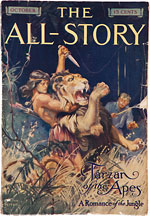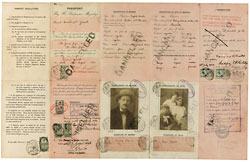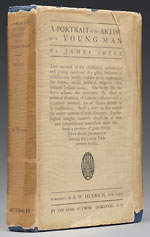 Ian McKay’s weekly column in Antiques Trade Gazette has been running for more than 30 years.
Ian McKay’s weekly column in Antiques Trade Gazette has been running for more than 30 years. Under the Sun
Galileo’s influential Dialogo, a manuscript herbarium, and golf classics shine
Tarzan and the Martians
Edgar Rice Burroughs, Tarzan of the Apes ($41,825), The Gods of Mars ($14,340), and Thuvia, Maid of Mars ($9,560), all at Heritage Auctions of Beverly Hills, September 12-13.
Only the second published work of this prolific writer, and the first to appear under his own name, the story that launched the Tarzan industry appeared first in a pulp magazine—the October, 1912 issue of The All-Story—preceding the McClurg book edition by some eighteen months.
It is thought that fewer than twenty copies now survive of that fifteen-cent magazine, which in the cover illustration by Clinton Pettee offers the first pictorial realization of the author‘s most famous and enduring creation.
This copy shows some wear and tear, and the back cover is almost detached, but generally speaking the condition is good. Heritage reported that “an apparent FN copy of this issue sold at auction for $59,000 in 2006,” though I have no further details on that sale.
The Tarzan pulp was part of the science fiction and fantasy collection of the late Jerry Weist, a fascinating, 1,500-lot sale of books, magazines, and original artwork from which I have selected just two other rare Burroughs items, both of which were first published in The All Story, but are here seen as first bookform editions.
Both are from his ‘Barsoom,’ or Martian series of SF stories. Inscribed and signed by the author, a beautifully preserved copy of Thuvia, Maid of Mars of 1920 was an obvious attraction and sold well at $9,560 against an estimate of $3,000-5000, but The Gods of Mars of 1918, only the second of these Martian tales, would appear to be much harder to find than the saleroom had reckoned. A good copy, but unsigned, it was valued at $300-500, but sold in the end for $14,340!
Portrait of Joyce as Writer and Family Man
James Joyce’s family passport, £61,250 ($100,934) at Sotheby’s London on July 14; Portrait of the Artist as a Young Man, $40,000 at Christie’s New York on June 23; Dubliners, estimated at $110,000-150,000 at Sotheby’s New York on October 20.
Joyce’s summer saleroom outings were led not by a book or even a manuscript, but by his first family passport. In the summer of 1915, whilst teaching in Trieste, he realized that Italy’s entry into WWI raised the possibility that he might be interned, so he, Nora, and the two children packed their bags and traveled to Zurich, Switzerland, where he applied to the British Consulate for the safeguard of an official passport.
Originally valid for two years, but renewed three times before, in 1923, he opted for his own individual passport, this one covers much of his greatest creative period, but there is also a notable fiction in the passport itself. Nora Barnacle is named as his wife, but they did not at the time enjoy that legal status. The couple had eloped from Ireland in 1904 but did not formally marry until 1931.
As to the books, well, a dust jacket of any sort is a rare sight on 1916, New York firsts of Joyce’s Portrait of the Artist and though this one is creased, shows some chipping, and has glue residue on the flaps, it certainly did a good job of raising the price. A much higher sum, however, is expected for the dust-jacketed copy of Dubliners to be offered by Sotheby’s New York as part of an ongoing dispersal of the Library of an English Bibliophile that began in London a year ago.
The publishing history of Dubliners is complex. Grant Richards planned to publish it in 1906, but the printers found certain passages objectionable, and despite Joyce’s protests, it was abandoned. In 1910, Maunsel of Dublin printed an edition of one thousand copies, but printers again took offence and after Joyce again refused to alter the text, that edition was destroyed.
In 1914, Grant Richards finally committed to printing the book as written, and by this time Joyce had added two important stories to the collection, “A Little Cloud” and the final and most famous story, “The Dead.” This review copy was sold for $15,400 as part of the Bradley Martin library at Sotheby’s New York in 1990, but it will be interesting to see how high the bidding goes this time.











